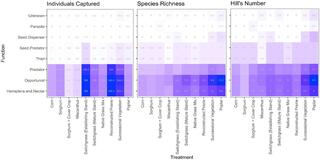Bioenergy cropping systems shape ant community composition and functional roles
N.L. Haan et al. "Bioenergy cropping systems shape ant community composition and functional roles" Frontiers in Conservation Service 4:1283225 (2024) [DOI:10.3389/fcosc.2023.1283225]
The adoption of biomass crops grown for energy is a likely source of major landscape change in coming decades during the transition from fossil fuels. There are a wide range of cropping systems that have not been widely deployed yet but could become commonplace, and our knowledge of their ecological attributes and biodiversity impacts is limited. Ants are prominent and functionally important components of grassland and agricultural ecosystems. Given their outsized influences on ecosystem structure and function, we sought to understand how ant communities are likely to be shaped by a range of bioenergy cropping systems. We characterized ant communities in a long-term experimental array in Michigan, USA containing ten dedicated bioenergy crops including annual monocultures, simple monoculture or near-monoculture perennial grasses, and complex polyculture systems. Community composition differed strongly among cropping systems, and ants were more abundant, species-rich, and functionally diverse in complex systems than in simpler systems, particularly annual crops. Our results illustrate the divergent effects that bioenergy crop adoption could have for ant communities and the important functions they carry out in agroecosystems.
The ant community dataset analyzed in this study is available at doi: 10.5281/zenodo.8215581. The functional information applied to each species, along with R code used to generate analyses, figures, and tables, is available at doi:10.5281/zenodo.10125287.
